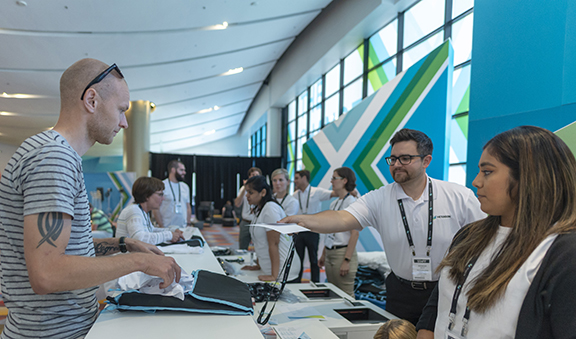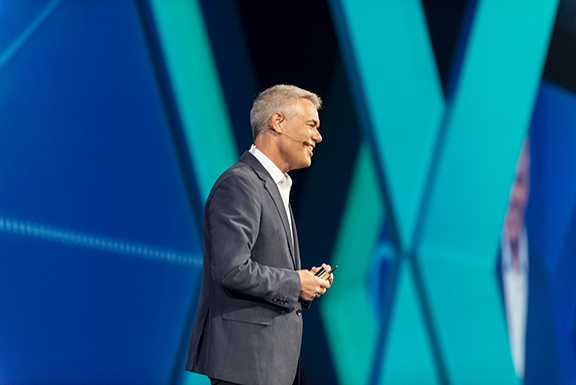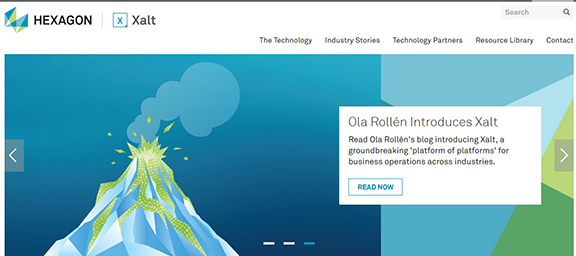LIVE from HxGN 2018: Surviving the Big Data Avalanche in the IoT Era

An estimated 3,500 attendees are at HxGN LIVE 2018 in Las Vegas this week (image courtesy of Hexagon).
Latest News
June 13, 2018
An avid skier, Hexagon CEO Ola Rollen found the right metaphor for what businesses must do today to survive and thrive—take a big leap.
This Tuesday, as Las Vegas sizzles in a heat wave reaching above 100*F, Rollen appeared before a cool backdrop of snowy hilltops, projected onto the main stage inside the Sands Expo.
“IoT is the avalanche of change bearing down on us—There’s no safe haven from it,” he told the estimated 3,500 attendees of HxGN LIVE (June 12-15, Las Vegas, Nevada), a conference devoted to Hexagon products and customers.
As for a survival tactic, Rollen saw fit to reshare the encouraging words he once received from his wife on a particularly bad day.
“She told me, when you’re chased by an avalanche, you have two options,” he recalled. “You can throw up your hands in the air and give up, or you can ski as hard as you can to outrun the avalanche.” (Watch the HxGN 2018 keynote video here.)
 Hexagon CEO Ola Rollen, discussing the need to take a leap to survive the data avalanche, during his keynote at HxGN LIVE 2018 (image courtesy of Hexagon).
Hexagon CEO Ola Rollen, discussing the need to take a leap to survive the data avalanche, during his keynote at HxGN LIVE 2018 (image courtesy of Hexagon).The IoT Data Avalanche
The real threat of IoT comes in the form of data—a data deluge that’s impossible for normal human processing.
The printing press, the internet, and IoT tipped the power scale toward data, Rollen told the HxGN LIVE audience.
“Data creation is outpacing data consumption,” said Rollen. “But with IoT, it’s like opening the floodgate. Now you have machines producing data, and they never sleep. They produce data 24-7 ... Our brains are not made to cope with all this data.”
Technology, he suggested, may be one of the ways to level the playing field between the men and machine.
“We need to put a shield between us and data. This shield consists of artificial intelligence (AI), cloud orchestration, and edge computing,” Rollen suggested. “Then we can dissect the data, make sense of it, and transform it into actionable information.”
Wrapped Up in Xalt
Typically, tech company CEOs launch new products with fanfare at conferences to induce attendees to buy them, but Rollen did the opposite. He introduced Xalt, a new technology you will not be able to buy.
“You will not be able to buy Xalt [pronounced Ex-salt],” he clarified,” because it’ll be gradually embedded into the products you’re using ... In the next four or five years, it will become a complete wraparound technology in all our platforms, systems, and products.”
In his own blog post on Xalt, Rollen describes the technology as “a framework for accelerating our customer’s ability to harness all data simply, even autonomously.” He further writes, “The goal of Xalt is to create Autonomous Connected Ecosystems, a state where data is connected seamlessly through the convergence of the physical world with the digital, and where intelligence is built-in to all processes.”
For manufacturing, Xalt is expected to improve factory performance and inventor management, enable machine learning for predictive maintenance, and empower field service technicians with real-time mobile access to product data, according to Hexagon’s Xalt product page.
 An estimated 3,500 attendees are at HxGN LIVE 2018 in Las Vegas this week (image courtesy of Hexagon).
An estimated 3,500 attendees are at HxGN LIVE 2018 in Las Vegas this week (image courtesy of Hexagon).Where the Digital and the Physical Worlds Converge
In mid-2017, Hexagon acquired MSC Software, a well-known simulation software developer. For Hexagon, which has historically focused on dimension verification (also known as metrology), the purchase represented an entry into new territories, into the realm of virtual simulation. MSC Software now belongs to the Hexagon Manufacturing Intelligence (HMI) division.
On Wednesday, in a briefing with the industry press, Paolo Guglielmini, CEO of MSC Software, revealed that the HMI division’s revenues are roughly 68% from dimension verification, 21% from simulation, and 11% from production software products.
How Products are Made, How Simulation Data is Managed
Designs live in the ideal state in CAD, in parametric geometric perfection, but “when things get made, when temperature, humidity, and others come into play, that’s when stuff happens to dimensions,” observed Angus Taylor, president of HMI, North America.
The combined use of metrology products and virtual simulation technologies, Hexagon envisions, is the best strategy to ensure product performance. Hence, the MSC Software acquisition.
“It may come as a surprise to some, but designers often don’t think about how a particular design is going to be made,” quipped Steve Sivitter, CEO of Vero Software, also part of HMI.
In the simulation of how things are made and how they perform in the field, multibody solvers like MSC Software’s Adam and computer-aided manufacturing software like Vero are expected to play an important role. Perhaps more important, in handling the explosion of simulation data and applying machine learning to simulation, customers may also turn to MSC Software’s SimManager.
In Rollen’s view, not taking the leap, or not outrunning the Avalanche is a much bigger risk for businesses. He pointed to the demise of Blockbuster, which failed to foresee the rise of Netflix, as a reminder.
As he literally jumped off the stage, Rollen said, “We all need to find the energy to take the great leap.”
We all need to find the energy to take the great leap. -Ola Rollen, Hexagon #HxGNLIVE pic.twitter.com/B340zLmBdk
— Digital Engineering (@DEeditor) June 13, 2018
Subscribe to our FREE magazine, FREE email newsletters or both!
Latest News
About the Author
Kenneth Wong is Digital Engineering’s resident blogger and senior editor. Email him at [email protected] or share your thoughts on this article at digitaleng.news/facebook.
Follow DE






